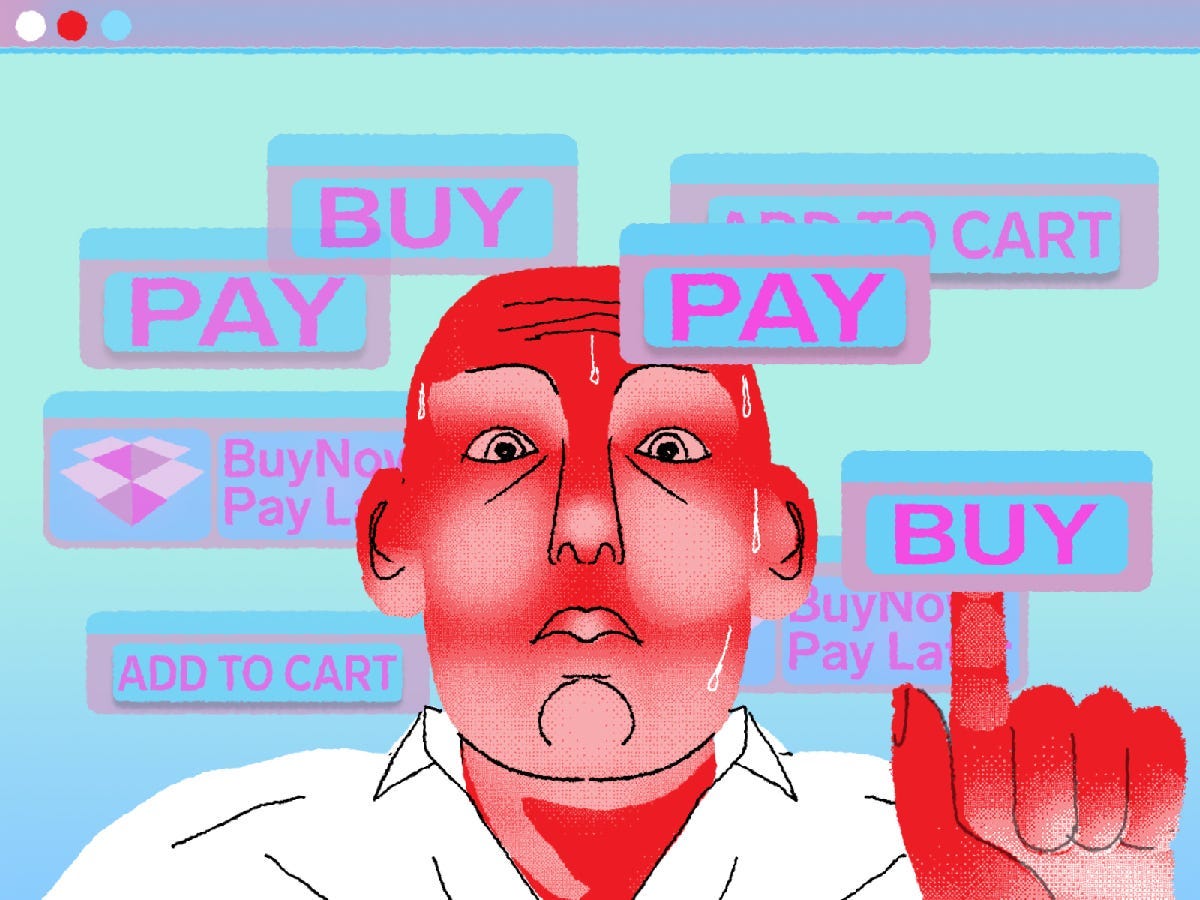As online sales have surged during the pandemic, retailers have learned to be more persuasive.Arif Qazi/Insider;
-
Online retailers use psychological tricks and tools to entice consumers to buy.
-
Experts told Insider that many retailers often resort to shoppers’ fear of missing out, or “FOMO.”
-
Retailers have been using these tactics for over a decade. But we shop even more online.
Online retailers use psychological tricks and marketing tools to entice consumers to make purchases. And as online sales have increased during the pandemic, retailers have learned to be more persuasive.
Companies rely more on first-party data to build personal relationships with customers and convince them to buy. This data will only become more important as social media ads become more expensive and internet cookies that help track users across different websites are phased out.
Experts speaking to Insider said many of the business strategies employed by retailers draw on shoppers’ fear of missing out on the latest and most popular products, or FOMO. Offering incentives for adding more items to online shopping carts, such as free shipping, is another example of the psychological tricks a retailer can use.
Nike and Lululemon are two leaders in using FOMO to sell products, according to Manini Madia, an associate professor at Columbia Business School and an expert on consumer behavior. The Lululemon app explicitly tells customers how many items are left in their size. In the meantime, Nike uses its SNKRs app to collect information about customers and uses notifications to keep them checking the app regularly.
“Nike does product drops in their SNKRS app. So you have to download the app, which means you give them your information. They have to turn on their notifications to show you when certain sneakers are going to drop, and they give you a window of 10am on a Saturday morning,” Madia said. “People who are sneakerheads know that this stock will be very limited and will likely sell out in the first few minutes.”
Retailers have been using tactics that close more sales and increase the order basket for well over a decade. But we’re shopping online now more than ever before, and those subtle nudges are starting to feel more pervasive.
“There are a lot of cognitive biases that retailers are aware of and use in shopping experiences. Most of them started in store and moved online,” said Jason Goldberg, chief commerce strategy officer at marketing firm Publicis Groupe and e-commerce expert nicknamed @Retailgeek.
Below are the tricks retailers use to trick you into buying more and tips on how to avoid them.
Getting a discount often means giving away your Saucony cell phone number
Discounts in exchange for a cell phone number
It has become more common for retailers to offer customers a 10% to 15% discount on their first order in exchange for an email address and cell phone number.
Opting in for email and text messages opens the door for customers to be contacted about everything from seasonal deals a business is offering to a reminder of items left in their carts.
“Having a cell phone number is probably the most valuable source of communication with a customer right now,” Madia said. Emails can be filtered or avoided altogether, but a consumer is much more likely to click on a text.
Some companies use this tactic better than others. The key is not bombarding buyers with communication. Startups like Klaviyo and Twilio, which provide technology for brands to create personalized customer engagement platforms, are being used by DTC companies like Who Gives A Crap and Solo Stove to build deeper relationships with customers.
“Communication needs to be tailored to how that customer is interacting with your brand,” says Madia. “If they bought a down coat and live in a zip code that has a four season climate in spring, you might want to show them some raincoats and then you have a better chance of getting them to complete a transaction.” .”
Apple Pay simplifies the payment process. S3studio/Getty Images
Apple Pay and buy now, pay later
Who hasn’t abandoned their online shopping cart because they were too lazy to pull a credit card out of their wallet? Multiple payment options have now been introduced to consumers to simplify the online purchasing process.
One-click checkout on Amazon, Apple Pay and Google Pay can store customers’ credit card information online. Buy Now, Pay Later Options With Klarna and Afterpay, shoppers can buy items now and set up monthly payment plans.
These payment forms make the checkout process easier and improve conversion rates for retailers who use them.
According to a study by Insider Intelligence and eMarketer, more than half of Gen Z digital shoppers will use a BNPL service by 2022. And the list of retailers across the industry adding Google Pay, Apple Pay, and PayPal as checkout options continues to grow.
These services “take the friction out of the last step,” Madia said.
Buy online, pick up in store
Buy online, collect in store has been all the rage during the pandemic. Retailers still love it as it saves shipping costs.
But there’s another benefit, says Madia. It’s a great way for retailers to increase a customer’s cart by bringing them to the store.
“You may want to pick up at the store because you want the item faster than it can be delivered,” Madia said. “But there’s a good chance you’ll buy something else while you’re there.”
A screenshot from J. CrewJ’s website. crew
scarcity
The insinuation that an article is scarce draws on what Goldberg of Publicis Groupe called our “lizard brain.”
So much of how we shop and make purchasing decisions is unconscious, he said, and while you may rationally know that scarcity is a marketing tactic, your subconscious doesn’t.
“That was a survival strength that served our ancestors really well,” he said. “We’ve probably outgrown the modern-day necessity part in many ways, but it’s still hardwired into our brain’s neuropathies.”
Examples of this tactic include when a retailer says there is limited stock of a product and it won’t be back in stock, when their website indicates an item is selling fast, or when items are in your shopping cart for a limited time only can be kept. While it may or may not be what Goldberg called “false scarcity” — meaning retailers actually stock a lot of the product — there’s no doubt that it’s effective.
Gracey Ryback, an Amazon influencer, hosts multiple live streams a week to promote Amazon products. Gracey Ryback
social proof
Positive ratings and reviews are the most common form of social proof. These provide “proof” that people bought a product before you and got a good result.
But we’re increasingly seeing more sophisticated versions of the social proof tactic. Depending on how much data retailers have about you, they can show you when people close to you or even people you follow on social media bought and liked a product. Then, of course, there’s influencer marketing, where celebrities and social media stars are paid to promote products tailored to what their audiences and followers might entice to buy.
“Sometimes the tactic is used to make you confident to buy the product, or sometimes to make you confident to pay that price for the product, or sometimes to choose that size for the product,” Goldberg said. “It tells you that this is very popular and that you should definitely buy it.”
Was/is pricing
We’ve all seen it when shopping online and in stores: a product has two prices listed, a higher one crossed out and a new, lower price.
This tactic, called was/is pricing, is designed to let shoppers know they’re getting a good deal — or, in some cases, to trick them into doing so.
“There’s an ethical version of this that’s actually happening, and then there’s an unethical version,” Goldberg said.
This type of pricing is common in outlets, he said. In an ethical example, a product that originally cost $100 ends up in an outlet store and is reduced to $30 – it’s a good deal indeed. But an unethical example would be when a product made just for an outlet and priced at $30 gets the was/is treatment, making you think you’ve gotten a bargain.
Tips to avoid retail marketing tricks
Just being aware of these marketing tactics isn’t enough to protect you from them, Goldberg said.
“What you can’t do is just say, ‘Oh, I’m smarter than marketing, and I’ll know about it, so I’ll avoid it,’” he said. “What you can do is build new habits that make these tactics less effective for you.”
Goldberg recommends giving yourself a “cool off” period after adding items to your cart, even if it’s just a few hours. Separating the add-to-cart process from the check-out process should help you make a more rational decision, he said.
Another tip: Don’t fall for the discounts and give your contact details to companies. That invites more targeted marketing, which can lead you to spend more.
Madia also suggested signing up for subscription and savings options on sites like Amazon for products you buy frequently.
“That way you’re not constantly going to Amazon, Target, or other sites that can prompt you to make an impulse purchase,” Madia said. “If you sign up for the paper towels, you don’t have to go in and complete a transaction where you might add some other items to your cart that you might regret later.”
Read the original article on Business Insider
Don’t miss interesting posts on Famousbio










